We may earn revenue from the products available on this page and participate in affiliate programs. Learn More ›
The secret to a garden that practically takes care of itself? Choose plants for your plot wisely, and you’ll be repaid in spades. Take the time to research the low-maintenance plants that do well in your area, plant them according to their needs and preferences, and you’ll have a lush garden packed with plants that require little to no attention.
How to Choose the Right Low-Maintenance Plants for Your Property
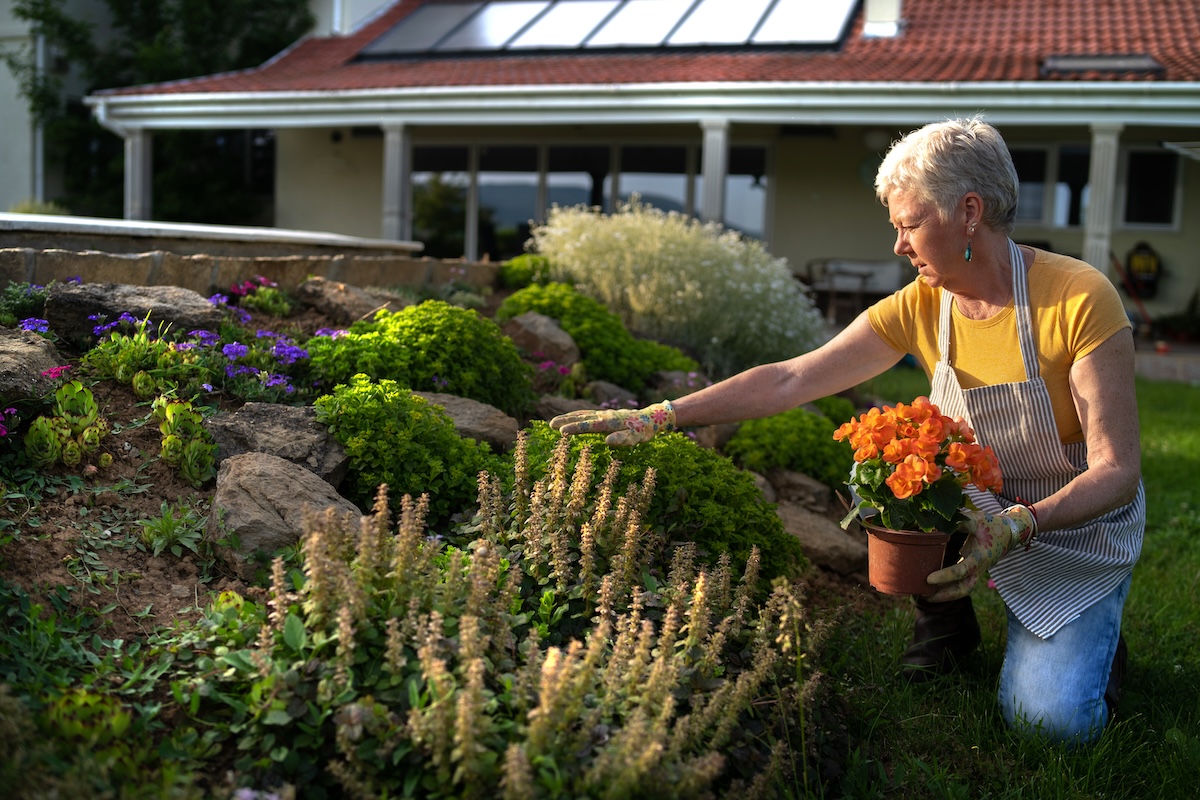
Some research to discover which landscaping plants are native to your area, or suitably adapted, will get you on your way to a lush, low-maintenance landscape. Look online to learn which plants are appropriate for your area; your county extension office website is a good place to start. And then consider these additional factors before you head to the plant store:
- Your USDA hardiness zone
- Sun exposure of the area you’re looking to fill
- Size of the area you need plants for
- Soil type and quality
- Water availability
Also think about:
- Pruning requirements
- Bloom habits of plants you’re considering
- Leaf, flower, or fruit drop—a messy plant next to a sidewalk or driveway may not be ideal
- Fertilization requirements
1. Coneflower (Echinacea)
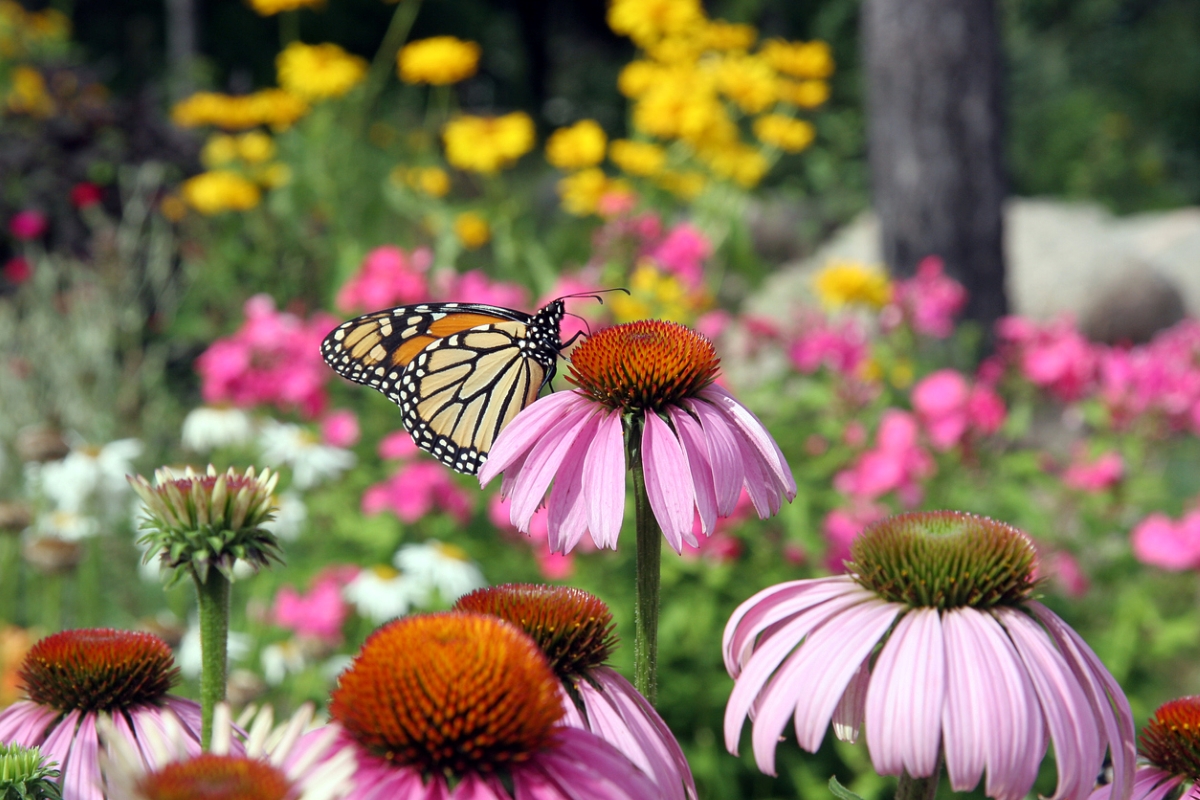
Where some plants struggle in poor soil, the purple coneflower thrives. Also known as echinacea, these perennial flowers native to the eastern United States attract pollinators and repel deer. In return, all coneflower requires is a trim in late summer to rejuvenate its bold blooms. Unless your area experiences severe drought, you can forget about watering your coneflower, and will only need to fertilize the plant in rare instances, like when buds remain undeveloped. Otherwise, assuming you choose a type that is native to your region, this is one plant that you can ignore all season long.
USDA hardiness zones: 3 to 9
Mature size: 2 to 4 feet tall by 1 to 2 feet wide
Important to know: Echinacea was used medicinally by indigenous peoples of the Great Plains, and contemporary studies have shown that taking echinacea may reduce the likelihood of catching a cold.
2. Creeping Thyme (Thymus serpyllum)
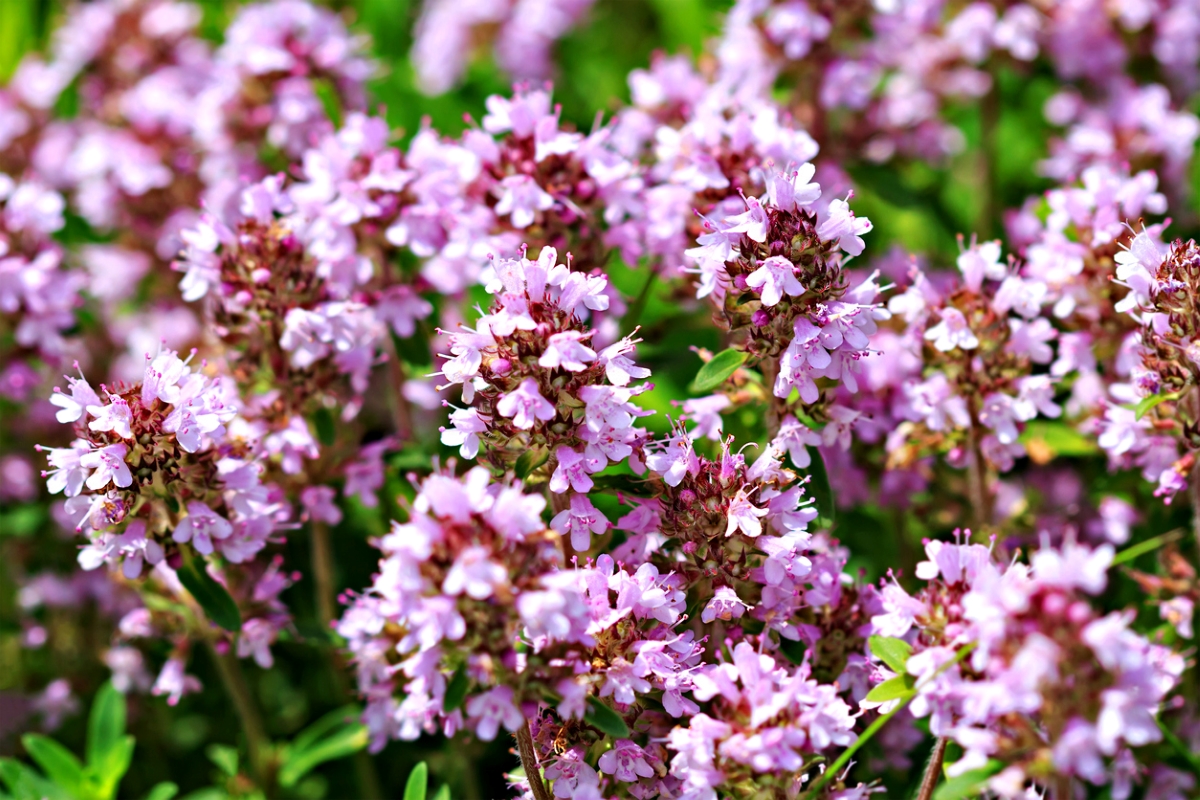
Creeping thyme is a favorite of home cooks and landscapers alike. This fragrant and edible perennial ground cover needs little more than warm weather and the occasional watering. Its hardiness and drought resistance recommends it as a lawn alternative, and its tiny white flowers lure butterflies to the yard. If an unseasonable freeze is in the forecast, cover your creeping thyme with a tarp to protect it until temperatures rise.
USDA hardiness zones: 4 to 9
Mature size: 2 to 3 inches tall; 3 to 10 inches wide
Important to know: Creeping thyme makes an excellent ground cover or even a turf grass alternative.
3. Creeping Sedum (Sedum)
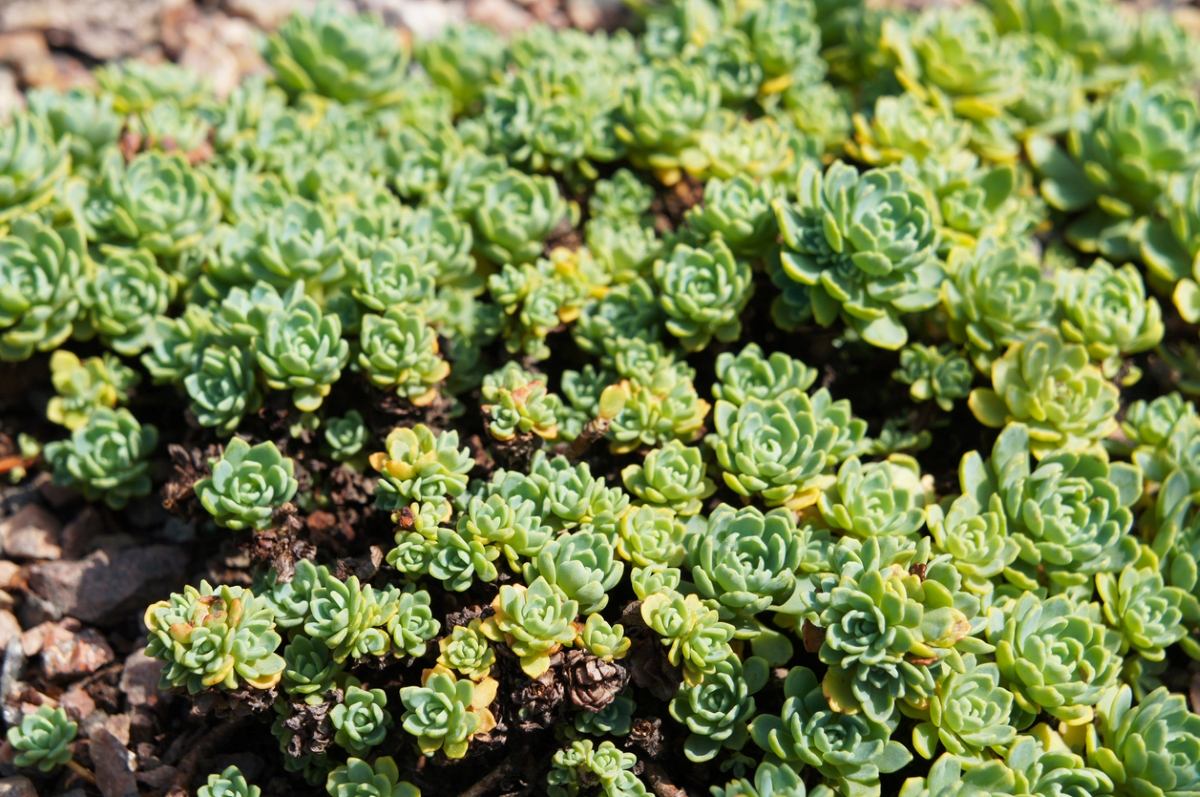
There are low-maintenance plants, and then there’s creeping sedum, a stalwart of low-maintenance landscaping. Available in myriad varieties, these succulents, also known as stonecrop, can survive unfavorable conditions of all kinds; be sure to determine which is best for your area. Plant creeping sedum in an arid region where it can thrive in the midst of drought, or line a driveway with stonecrop, where it will survive runoff from road salt used to melt winter ice. These succulents come in every color from bluish-gray to reddish-bronze, and can find a home in most any garden.
USDA hardiness zones: 3 to 11
Mature size: 3 to 12 inches tall; 3 feet wide
Important to know: Typically deer resistant
4. Texas Ranger (Leucophyllum frutescens)
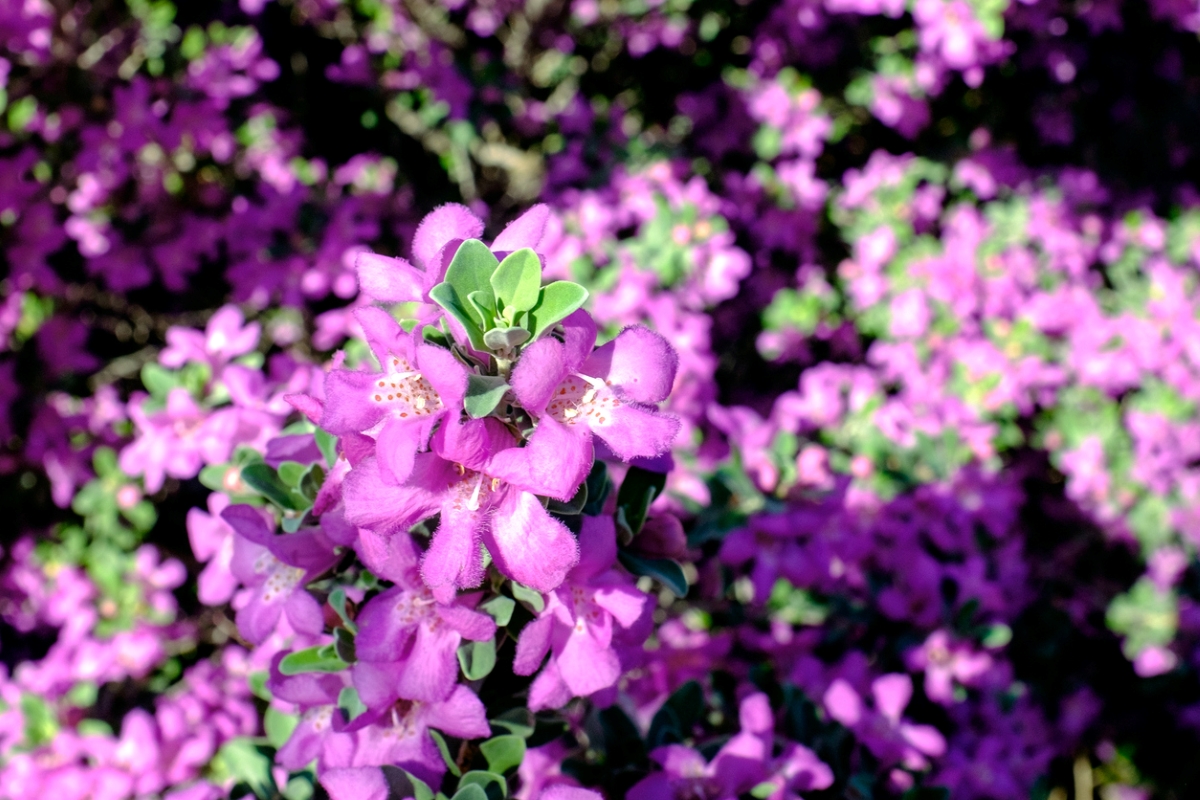
Also known as wild lilac, Texas ranger wows with vibrant lavender, purple, and magenta blooms. For all its showy blossoms, this flowering shrub is surprisingly low maintenance. Plant it in full sunlight, then water it only during times of severe drought to be rewarded with splashy color and curb appeal.
USDA hardiness zones: 7 to 13
Mature size: 2 to 10 feet tall; 4 to 6 feet wide
Important to know: Deer resistant
5. American Beautyberry (Callicarpa americana)
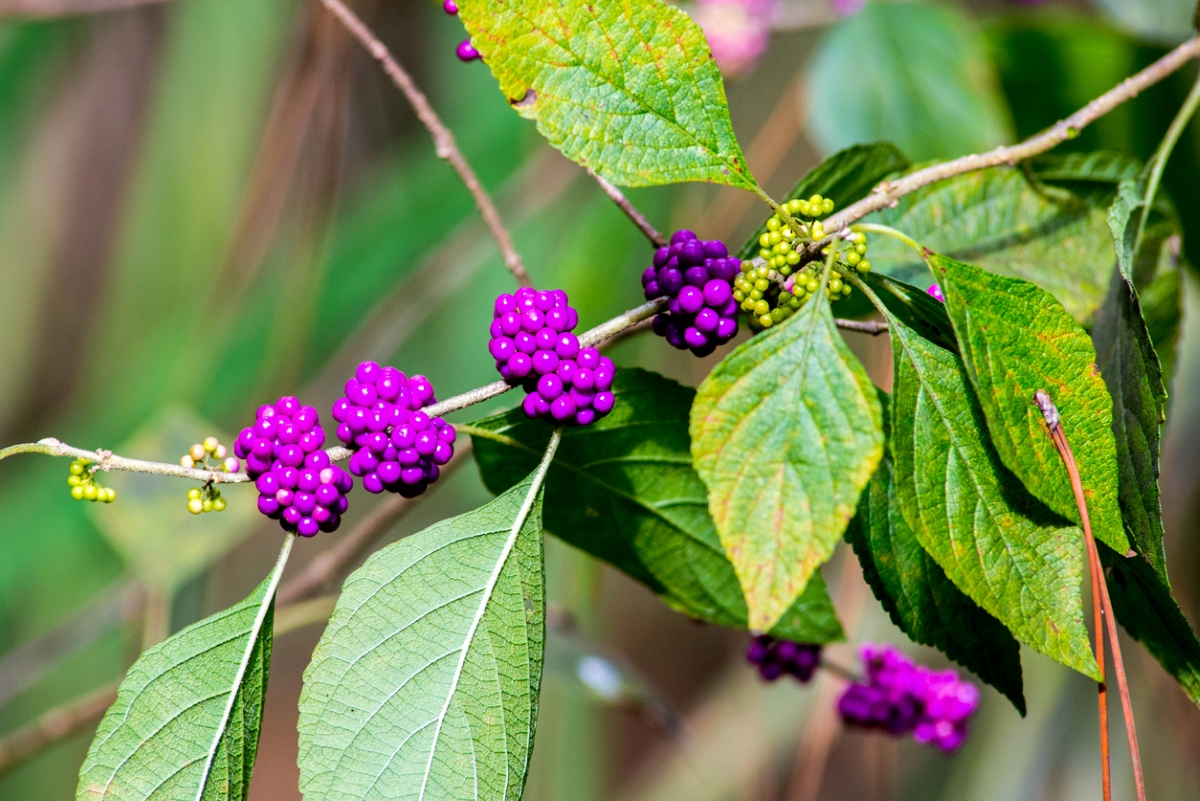
If you want a low-maintenance plant with year-round color, look no further than the beautyberry shrub. After months of green foliage speckled with lilac blooms in the spring and summer, the beautyberry’s leaves fall away to reveal dazzling purple berries (a favorite snack for birds) for most of fall and winter. Virtually drought-tolerant and resistant to disease and pests, this is one garden variety that requires little to no effort on your part once you’ve planted it.
USDA hardiness zones: 7 to 11
Mature size: 5 to 8 feet tall; 5 to 6 feet wide
Considerations/important to know: While deer do love the tender shoots of springtime, they won’t eat this bush to the ground.
6. Hosta (Hosta)
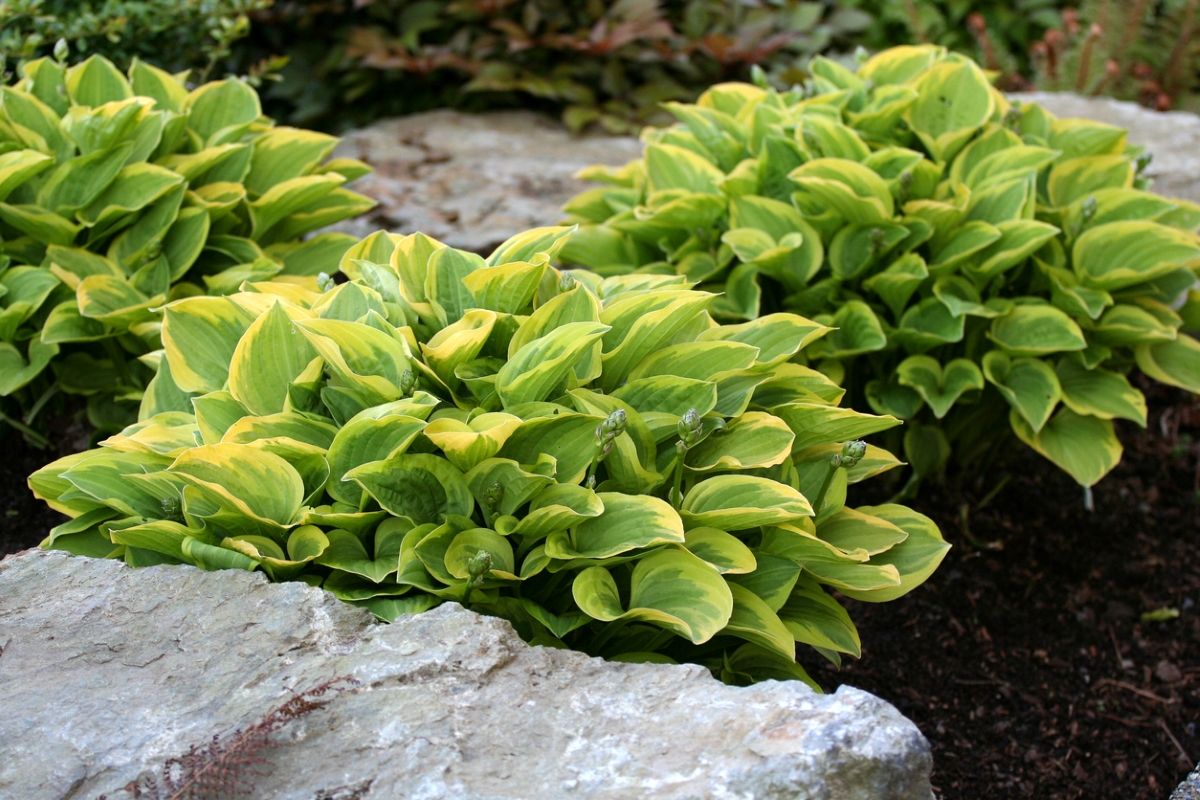
Looking for low maintenance and lots of options? If you live in a place that gets plenty of rain, and where the soil remains moist, consider leafy hosta plants, which do particularly well in yards with plenty of shade. With thousands of varieties available, Hosta sports green, gold, or variegated leaves that provide a nice backdrop to more colorful plants. Once established, watch this lush plant become a regular landscape addition, returning year after year.
USDA hardiness zones: 2 to 10
Mature size: 0.75 to 2.5 feet tall; 1 to 8 feet wide
Important to know: Hosta is toxic to cats, dogs, and horses. It can cause skin irritation in humans.
7. Meadow Sage (Salvia pratensis)
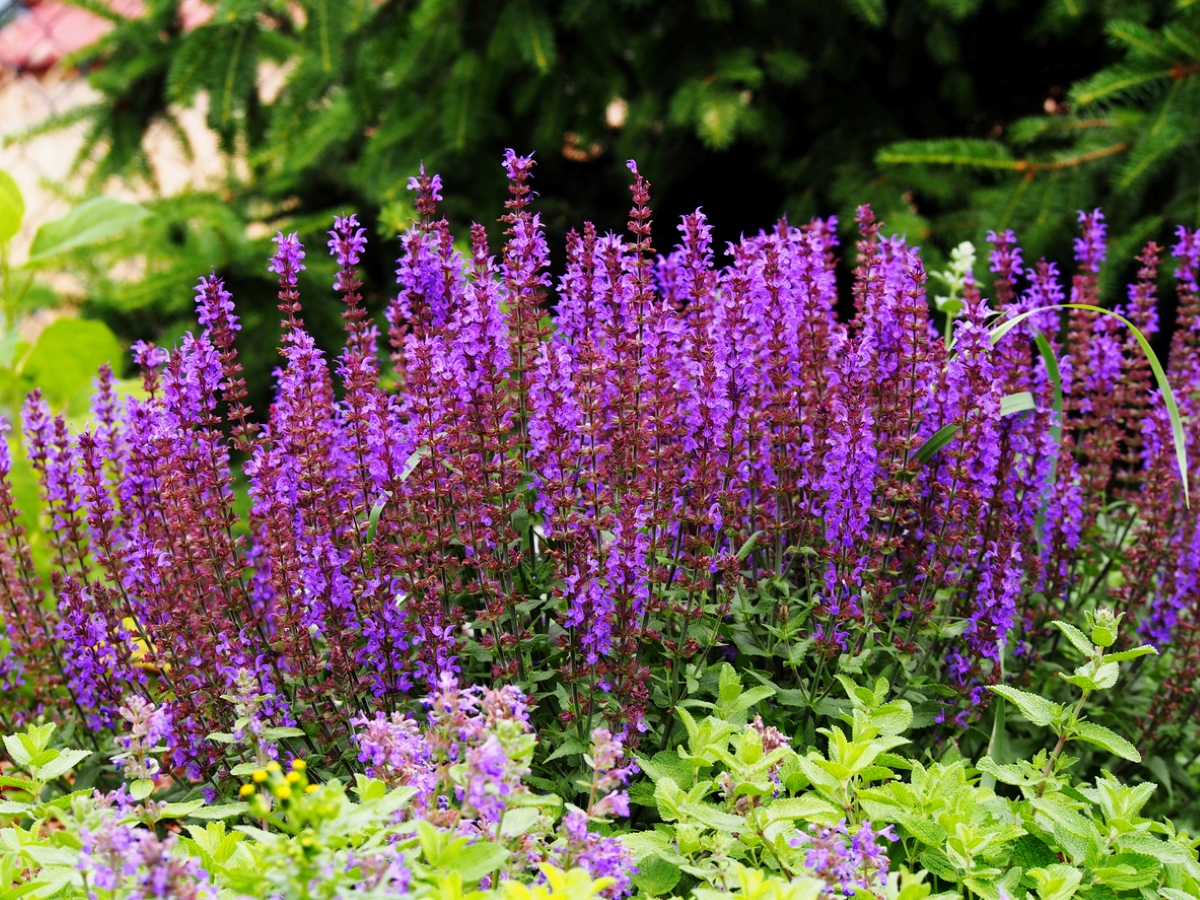
Hummingbirds, bees, and beginner gardeners love the color that meadow sage‘s long-blooming flowers bring to the garden. The long stalks are an easy way to add deep and vibrant violet hues to your landscape. This perennial handles full sun, and holds up to neighborhood deer visiting with the munchies.
USDA hardiness zones: 4 to 8
Mature size: 1 to 3 feet tall; 1 to 3 feet wide
Important to know: Favored by butterflies and hummingbirds
8. Peppermint (Mentha piperita)
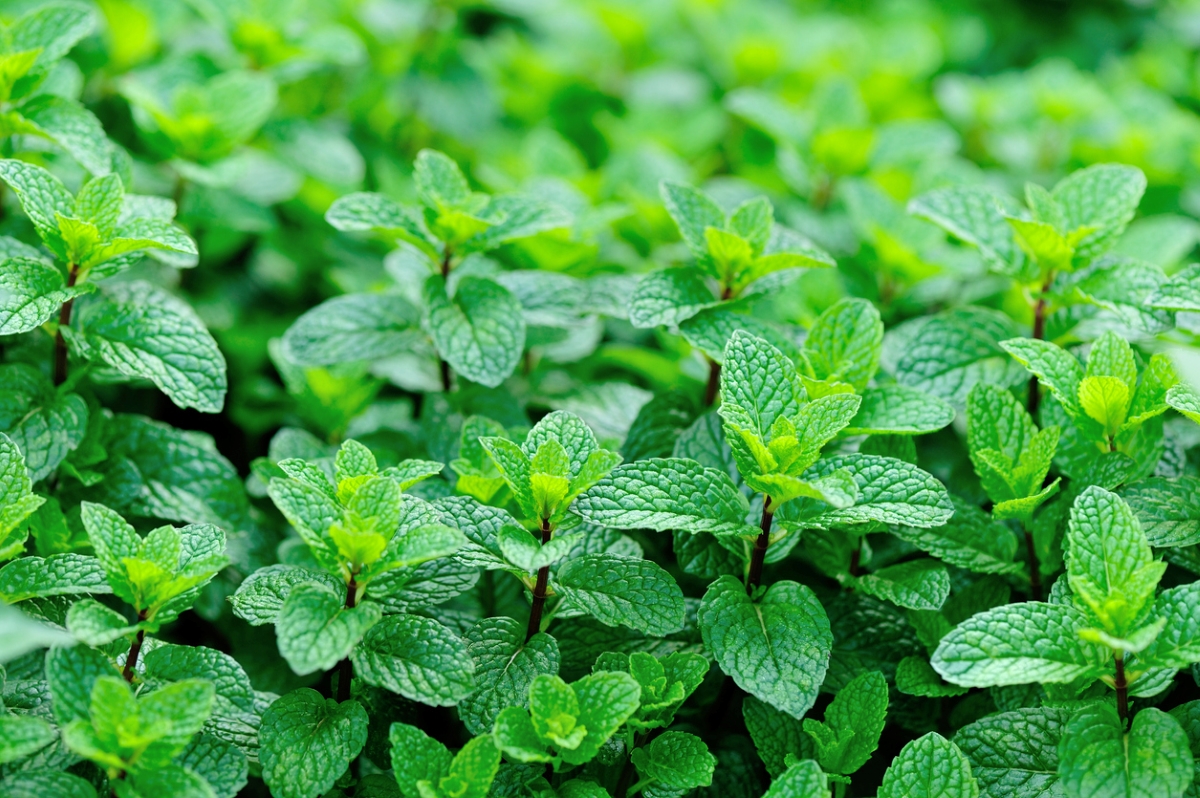
You may be familiar with the aromatic mint plant’s usefulness in both mojitos and repelling mosquitoes. But the lack of maintenance this plant requires to boot is as much a blessing as it is a curse: Peppermint plants’ invasive roots grow so quickly that they can overtake your garden. Keep this fresh greenery potted in containers that transfer easily from the windowsill to patio to reap its benefits all year long.
USDA hardiness zones: 3 to 8
Mature size: 1 to 1.5 feet tall; 1.5 to 2 feet wide
Important to know: Extremely invasive
9. Black-Eyed Susan (Rudbeckia hirta)
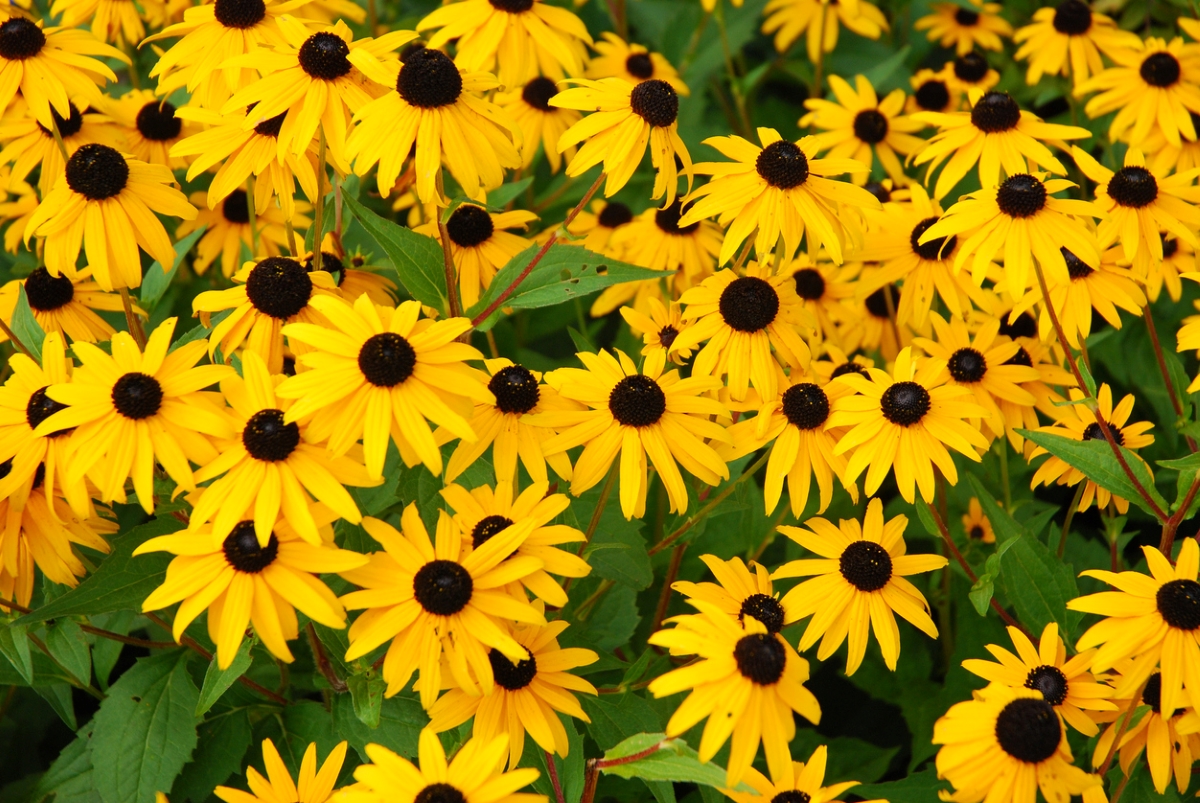
Drought-tolerant and disease-resistant, the bright yellow flowers with big, brown-to-purple centers of the Black-Eyed Susan are some of the easiest plants to take care of for outdoor gardens. And if their sunny color alone doesn’t make you smile, the butterflies they attract to your yard may do just that. But beware: The yellow-budded perennial also lures wildlife like rabbits and deer to your garden patch, so it’s best to place them near plants known to be repellents, like lavender and rosemary.
USDA hardiness zones: 3 to 11
Mature size: 1 to 5 feet tall; 1 to 3 feet wide
Considerations/important to know: Good for containers; good for cut flowers
10. Dusty Miller (Jacobaea maritima)
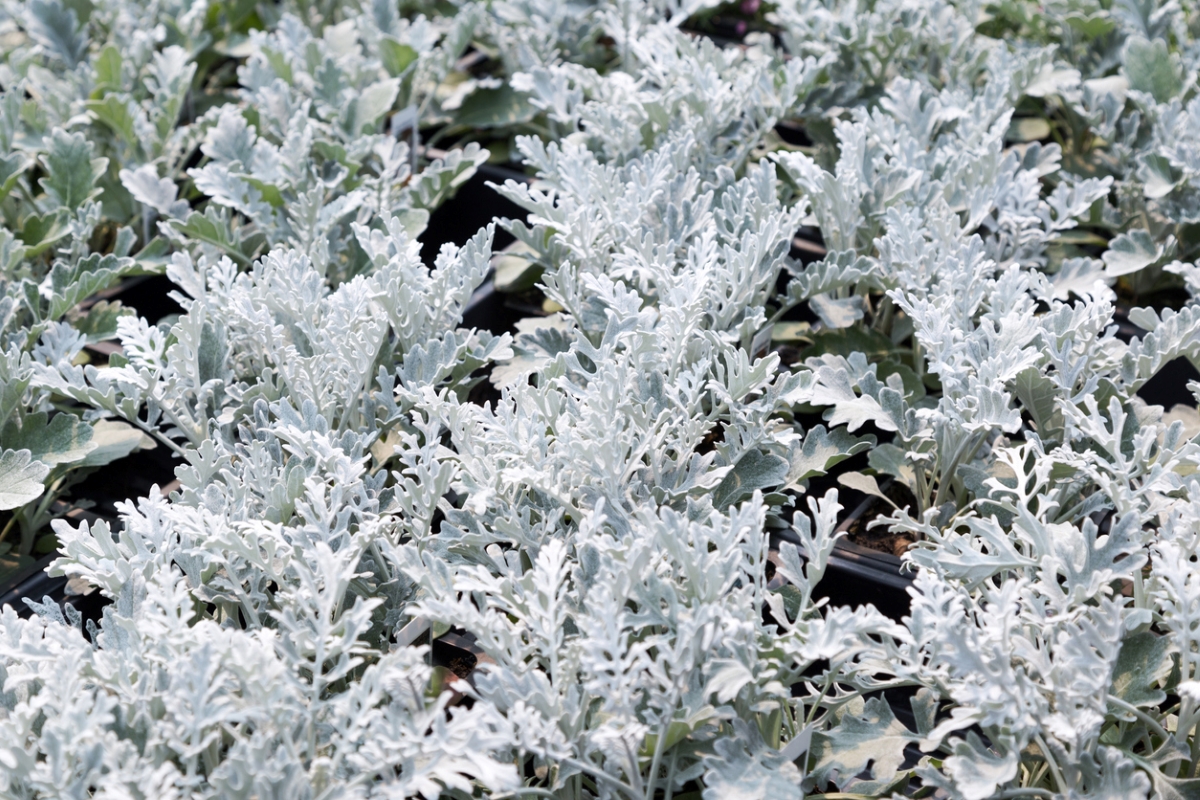
Dusty miller makes a striking statement in any garden. The lacy, silver-gray leaves of this plant contrast with the typical green foliage of other plants, so it works nicely as a lush backdrop for shorter plants or as a border around taller plants. Besides its beauty, dusty miller has another noteworthy quality: ease of maintenance. The deer-resistant plant requires little care once established, and it will happily tolerate both heat and drought.
USDA hardiness zones: 7 to 10
Mature size: Height: 6 inches to 1 foot; width: 6 inches to 1 foot
Important to know: Can become leggy; keep it trimmed up to prevent this.
11. Lamb’s Ear (Stachys byzantina)
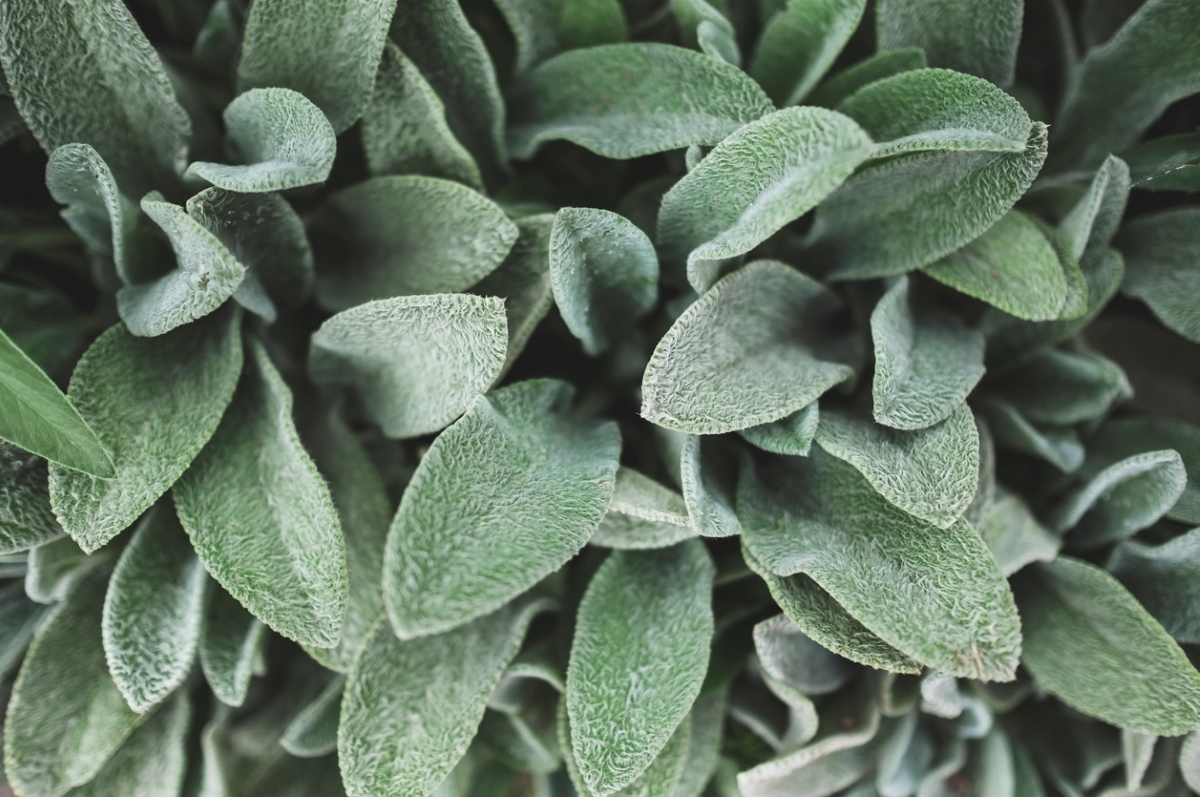
Lamb’s-ear gets its moniker from its soft, fuzzy, silver-green foliage, which resembles a real lamb’s ear. The low-growing perennial is often used as a border plant or ground cover, and it bursts with spikes of pink-purple flowers in the spring. In addition to requiring little maintenance once established, Lamb’s-ear easily handles both drought and poor soil conditions. As with all flowering plants, it’s best to deadhead blooms once they’re spent, but Lamb’s-ear will thrive whether you deadhead or not. For best results, grow it in areas of full sun or partial shade with well-draining soil.
USDA hardiness zones: 5 to 8
Mature size: 6 to 12 inches foot tall; 2 to 5 feet wide
Important to know: Susceptible to root and crown rot
12. Arkansas Blue Star (Amsonia hubrichtii)

The feathery green foliage of Arkansas blue star changes with the season. After blooming with soft-blue, star-shaped flowers in the spring, it develops green feathery needle-like leaves in the summer, which turn brilliant gold in the fall. The leaves remain through a portion of the winter months as well. Low-maintenance Arkansas blue star resists deer and drought, making it a durable and beautiful option for any garden. Many homeowners combine the perennial with other grasses or use it as a border plant. Grow Arkansas blue star in full sun to partial shade, and make sure it’s planted well-draining soil.
USDA hardiness zones: 4 to 9
Mature size: 3 feet tall and wide
Important to know: The plant’s milky white sap can irritate skin.
13. Fountain Grass (Pennisetum setaceum)
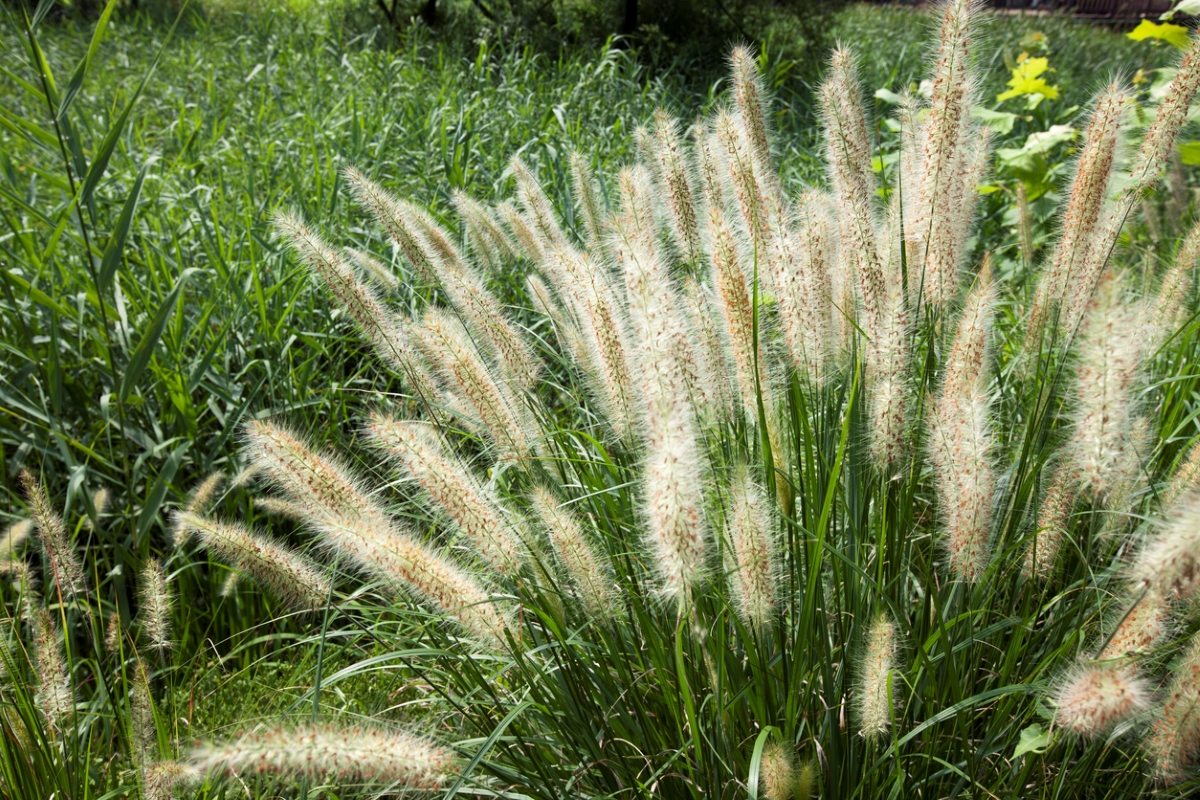
Fountain grass has feathery, cascading blooms that bring dramatic interest and texture to your yard, especially when planted in groups. The perennial grows in a mound shape, and its tan, pink, or purple flowers appear in late summer and fall. Since fountain grass thrives in dry soil, it’s ideal for drought-prone regions. It’s also very adaptable, making it an extremely low-maintenance plant. For an attention-grabbing garden design, grow this ornamental grass as an accent among other shrubs or green perennials.
USDA hardiness zones: 3 to 10
Mature size: 2 to 3 feet tall and wide
Important to know: Cut fountain grasses back to about 6 inches tall in late winter.
14. Catmint (Nepeta)
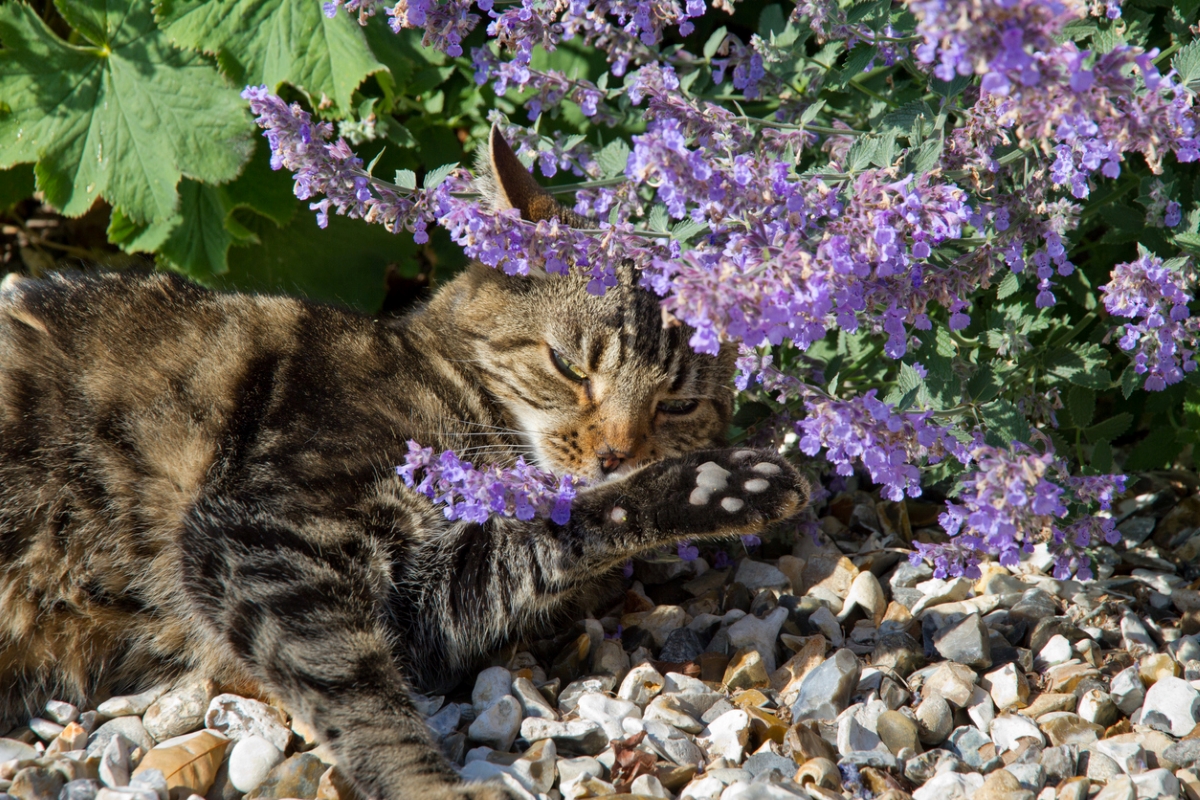
Catmint, a non-culinary mint variety, is a long-living perennial with beautiful purple-blue flowers and gray-green foliage. Blooming in early spring, catmint grows up to 3 or 4 feet tall. Gardeners often plant the aromatic herb in rock gardens or along edging. Catmint is easy to grow, tolerates both heat and drought, and resists deer and rabbits. Pruning the flowers after they’re spent may give you another show later in the season.
USDA hardiness zones: 3 to 8
Mature size: 1 to 24 inches tall; 1 to 2 feet wide
Important to know: Cats are attracted to this plant.
15. Clematis (Clematis L.)
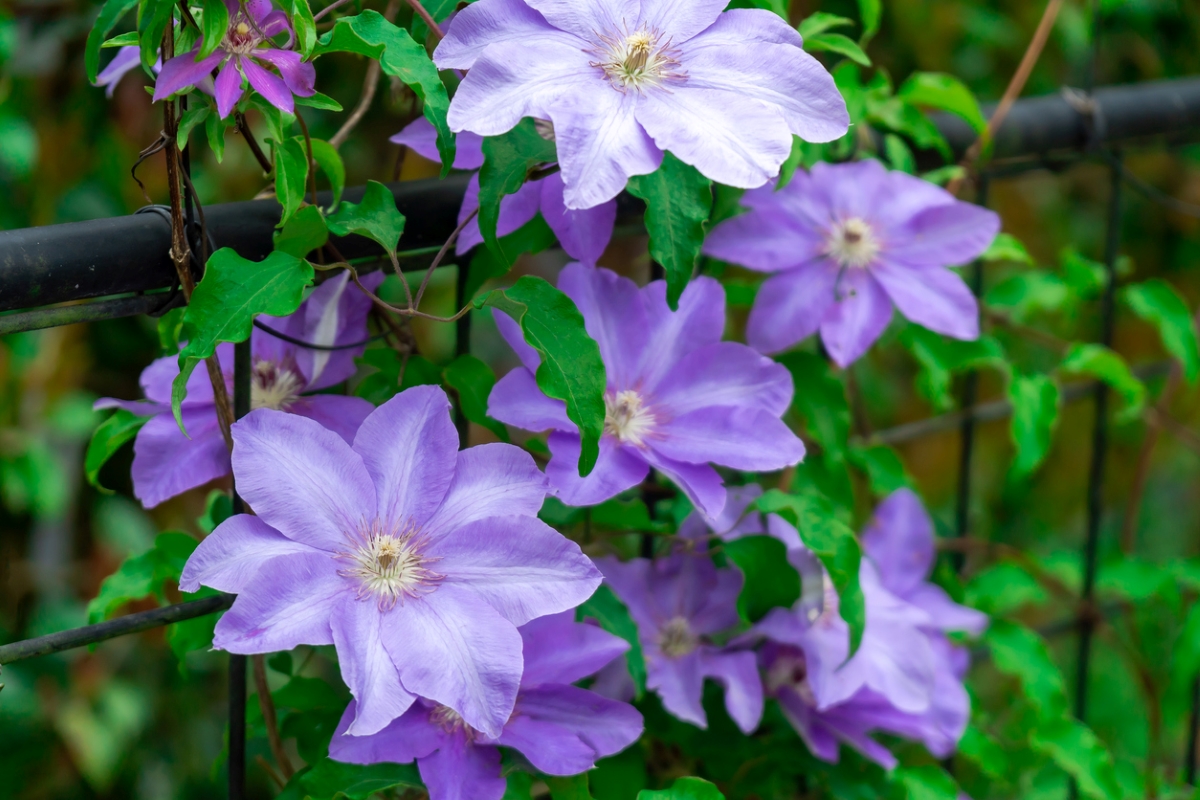
Tremendously popular with American gardeners since the late Victorian era, clematis satisfies not only in the rapid speed of its growth, but also in its delightful tendency to climb and cover outdoor structures, lending shade, privacy, and undeniably charming curb appeal. The color, size, and timing of clematis blooms differ by variety. Some explode with large, violet-petaled flowers in the middle of spring, while others produce small, white blooms, which arrive in late summer or fall. All that said, no matter which variety you choose, you can expect the hardy perennial to always fare best when positioned in full sun and planted in cool, moist, well-draining soil.
USDA hardiness zones: 4 to 9
Mature size: Shrubby types may be as small as 2 feet tall and wide; trailing types can grow to 50 feet long.
Important to know: Consider varieties that are highly fragrant in order to perfume your landscape.
16. Coral Honeysuckle (Lonicera sempervirens)
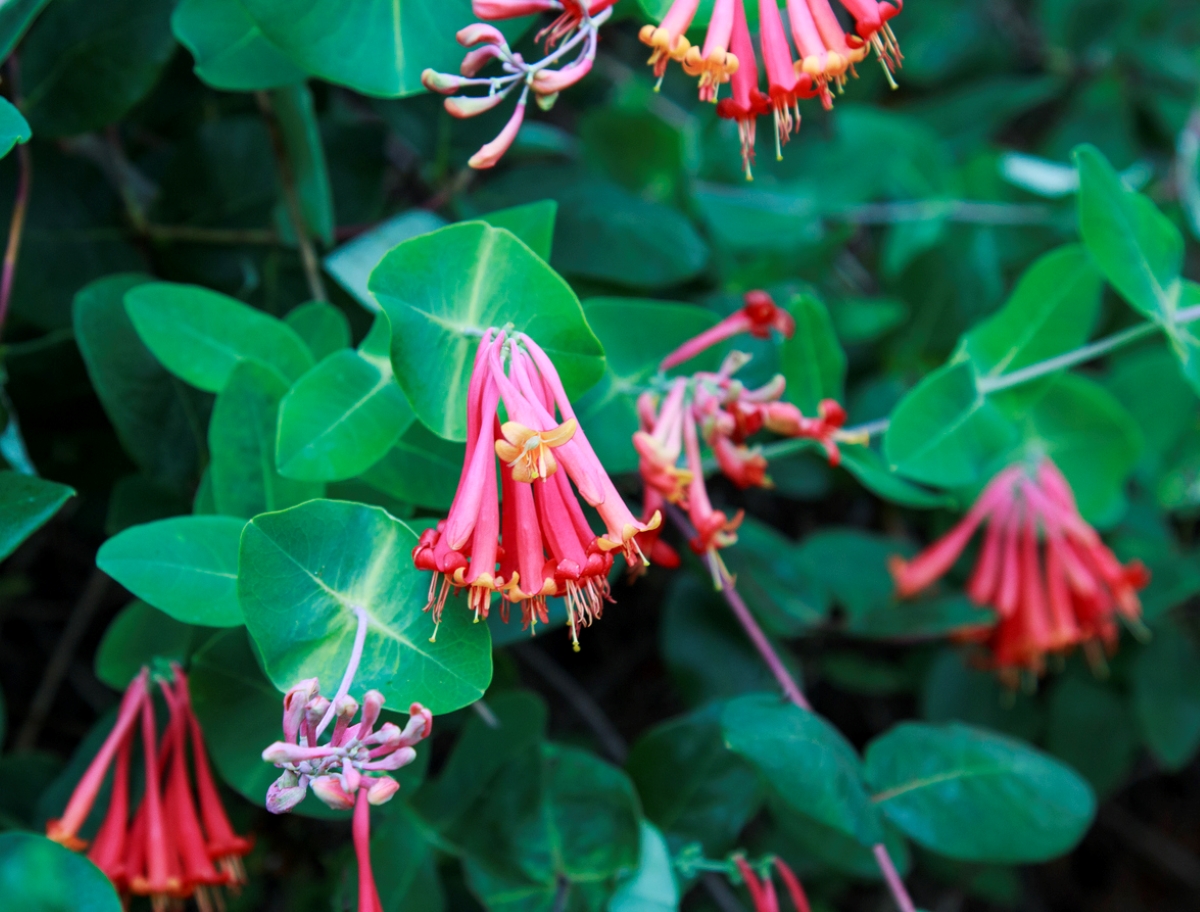
Virginia native coral honeysuckle grows naturally across much of the United States, from the northern reaches of Maine all the way down to the Florida Panhandle and as far west as Illinois. This means, despite the look of its show-stopping, hummingbird-attracting, trumpet-shaped blooms—or its bright-red, later-summer berries—this twisting, twining vine needs no special attention. Grow these flowers for ground coverage in full sun or partial shade, and don’t worry too much about watering, as coral honeysuckle withstands drought admirably well. Note only that if you wish for the vine to climb rather than grow into shrub or a ground cover, you must train it to do so with narrow supports.
USDA hardiness zones: 4 to 11
Mature size: 15 to 25 feet tall and wide
Important to know: Toxic to pets
17. Butterfly Bush (Buddleja davidii)
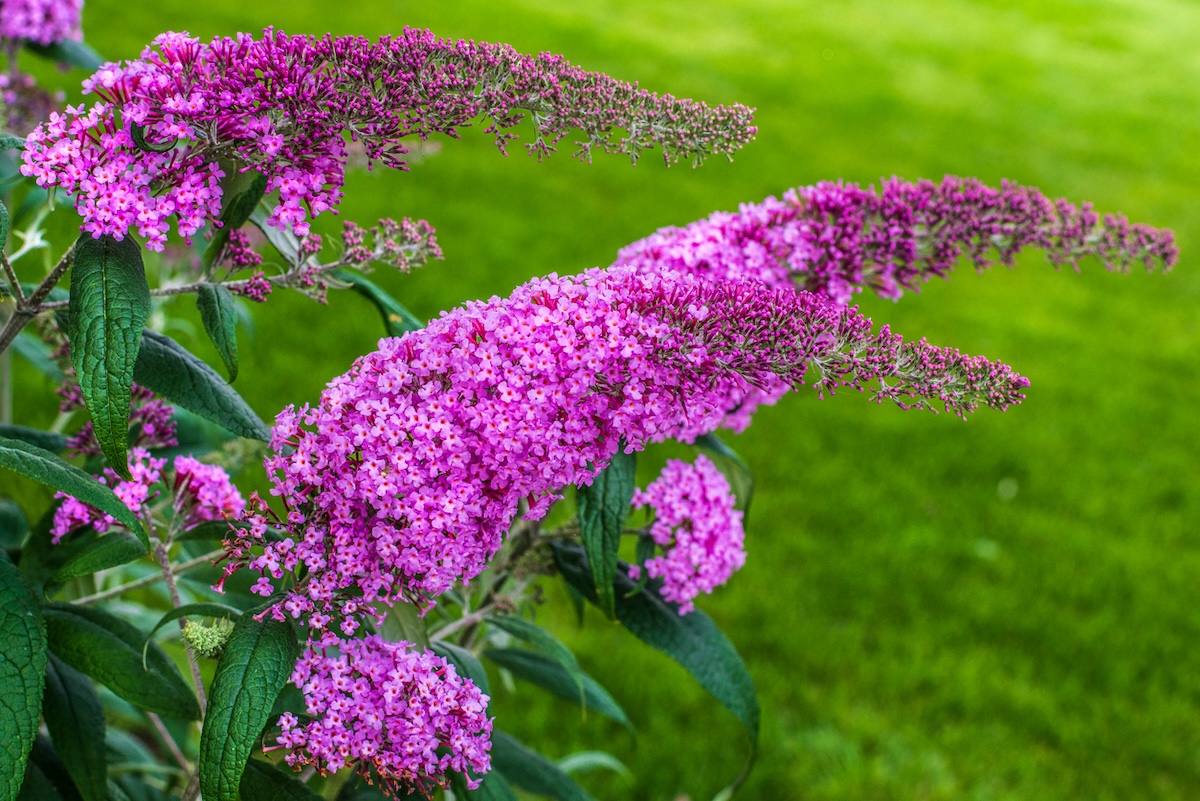
Why do so many homeowners continue to plant butterfly bush, even though many experts now consider the Asian import to be an invasive species? Simple: Among bushes for landscaping, butterfly bush is a truly tough shrub made beautiful by eye-catching trusses of pink, white, or purple blooms. In addition, true to its name, butterfly bush typically doesn’t fail to attract—you guessed it!—butterflies. So, there’s a lot to like. However, unless you’re prepared to see butterfly bushes take over your garden, and perhaps your neighbors’ gardens as well, remember that you must make sure to select a sterile, non-invasive variety, one whose full, mature size would fit in the sunny spot you plan for it to occupy.
USDA hardiness zones: 5 to 9
Mature size: 3 to 12 feet tall; 3 to 8 feet wide
Important to know: This plant can be invasive in some environments.
18. Bog Rosemary (Andromeda polifolia)
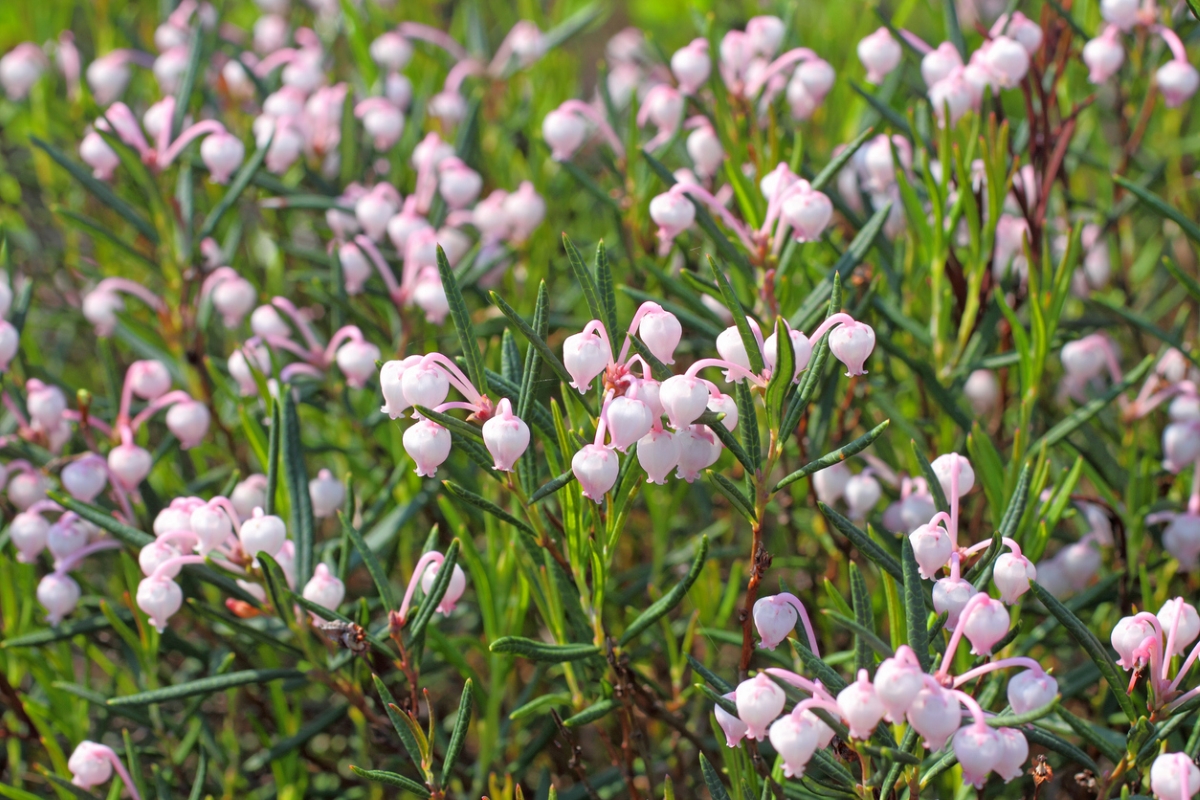
Gardeners would be wise to remember that in nature, bog rosemary grows in soggy wetland areas. That means, if you don’t want to drive yourself crazy watering the compact, rounded shrub over and over again, you must be sure to plant rosemary in soil that stays consistently moist. Also, bear in mind that bog rosemary (no relation to the herb rosemary) can be poisonous if ingested, so you may not want to plant this if you have pets or children. All that said, as long as you can give the evergreen a suitable home, you can expect it to thrive without much care or pruning, and for masses of bell-shaped flowers to join the bluish, needle-like foliage from mid to late spring.
USDA hardiness zones: 2 to 6
Mature size: 0.75 feet to 3 feet tall; 3 feet wide
Important to know: Toxic to humans and pets
19. Houseleek (Sempervivum)

The common name “houseleek” refers to a diverse family of succulents with 40 distinct, identifiable species and hundreds more hybrids. Color, texture, shape, size: All are variable, sometimes wildly so, from one exotic-looking specimen to the next. Despite their diversity, houseleeks do share one key thing in common: the ability to withstand drought, wind, frost, and indeed, most any challenging situation, with the strong exception of waterlogged soil. Unless you live somewhere with sandy or gravelly soil, ensure proper drainage by planting each houseleek on small mounds. Once they’re in the ground, houseleeks demand next to nothing of their caretakers, a fact that seems only fitting, given that the Latin name for houseleek roughly translates to “forever living.”
USDA hardiness zones: 3 to 8
Mature size: 6 inches tall and wide
Important to know: Some varieties are toxic to humans and pets.
20. Creeping Jenny (Lysimachia nummularia)
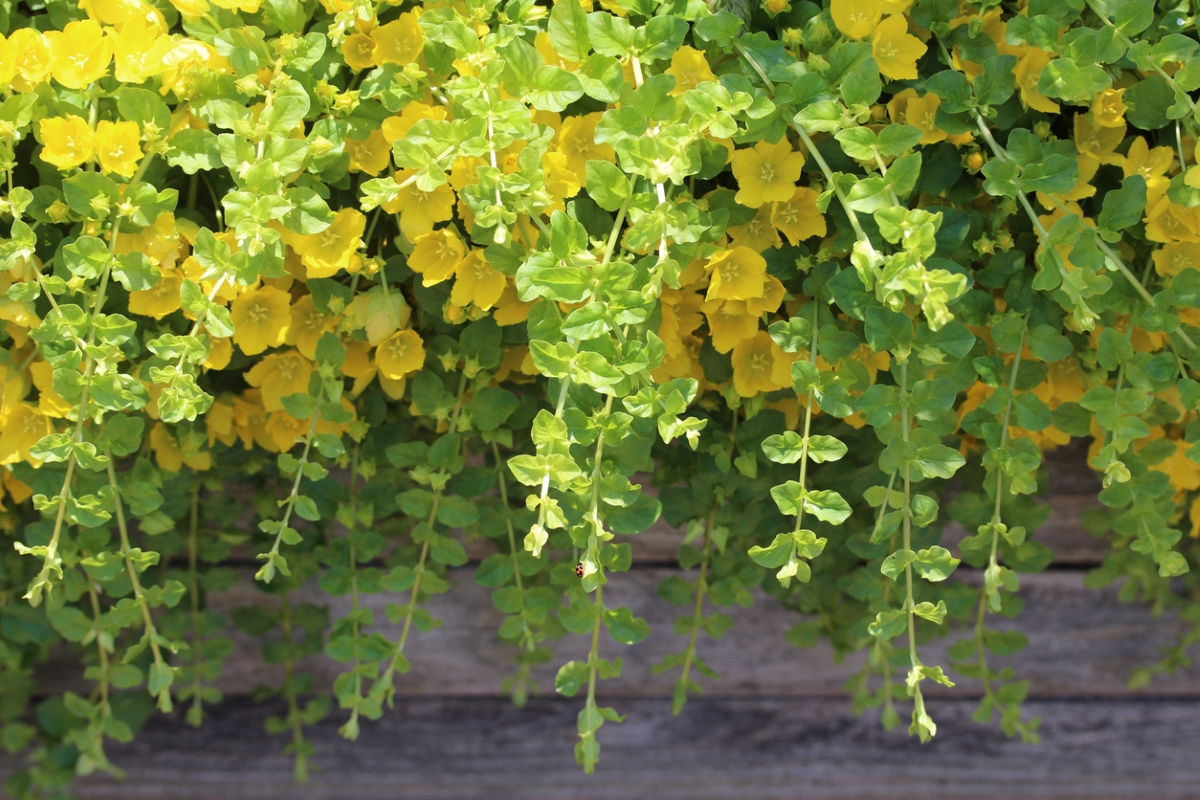
If your backyard is looking a bit bare, creeping Jenny is an ideal, low-maintenance plant. This ground cover spreads to fill empty areas while providing a splash of color with its bright green and yellow leaves. It’s also an excellent “spiller” for cascading over pots or walls. Thriving in average to rich, moist soil, creeping Jenny loves soaking up the sun from late spring into summer.
USDA hardiness zones: 3 to 11
Mature size: 2 to 4 inches tall; 1 to 1.5 feet wide
Important to know: Can be invasive.
21. Knock Out Roses (Rosa ‘Knock Out’)
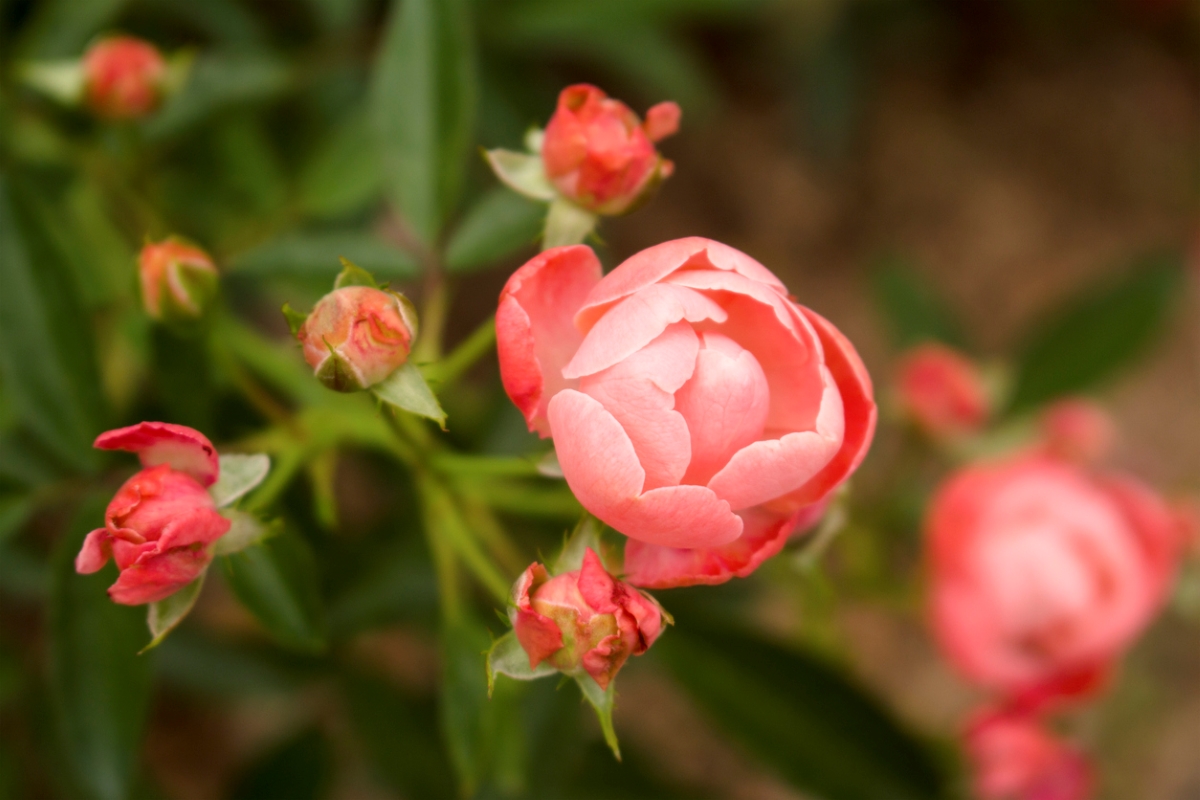
From their bold color to easy care, Knock Out roses are everything the name promises. Easy to grow and resistant to many diseases, they’re a good choice for lazy gardeners. Of course, like all roses, they will look best if you put some effort into maintenance. For best results, plant Knock Out roses where they’ll receive plenty of sunlight, and prune shrubs after the last frost. Of course, this hardy rose bush will continue to bloom year after year, even if you don’t lift a finger.
USDA hardiness zones: 5 to 9
Mature size: 6 feet tall and wide
Important to know: While these roses are known for their disease resistance, they can be susceptible to fungus.
22. Ice Plant (Mesembryanthemum crystallinum)
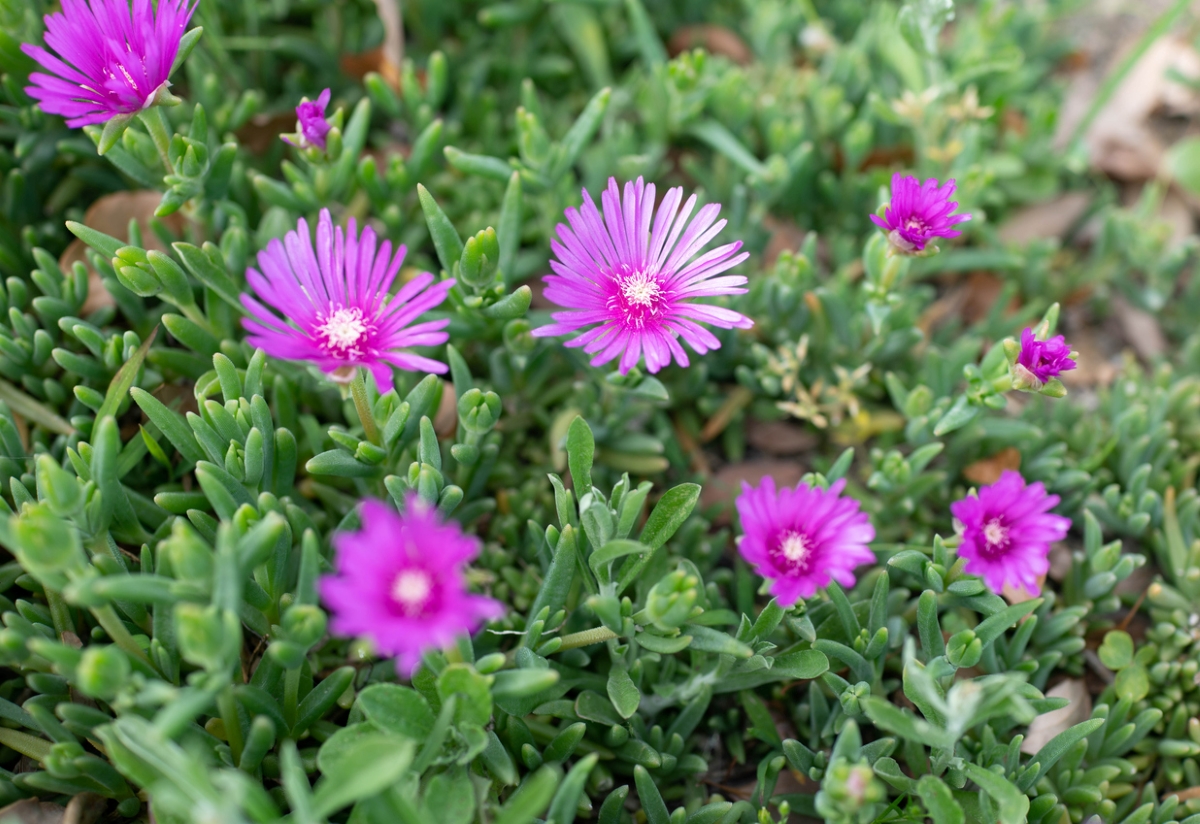
If you live in a dry, arid region, you probably want a garden that looks good without draining your tap or your wallet. That’s where the ice plant excels. This beautiful bloom is heat- and drought-tolerant, although it cannot survive in zones where winter frost is a danger. This colorful succulent thrives in rocky soil and can go as long as two weeks without water, making it a perfect addition to your desert garden.
USDA hardiness zones: 6 to 10
Mature size: 3 to 6 inches tall; 1 to 2 feet wide
Important to know: Deer resistant
23. Brookside Geranium (Geranium ‘Brookside’)
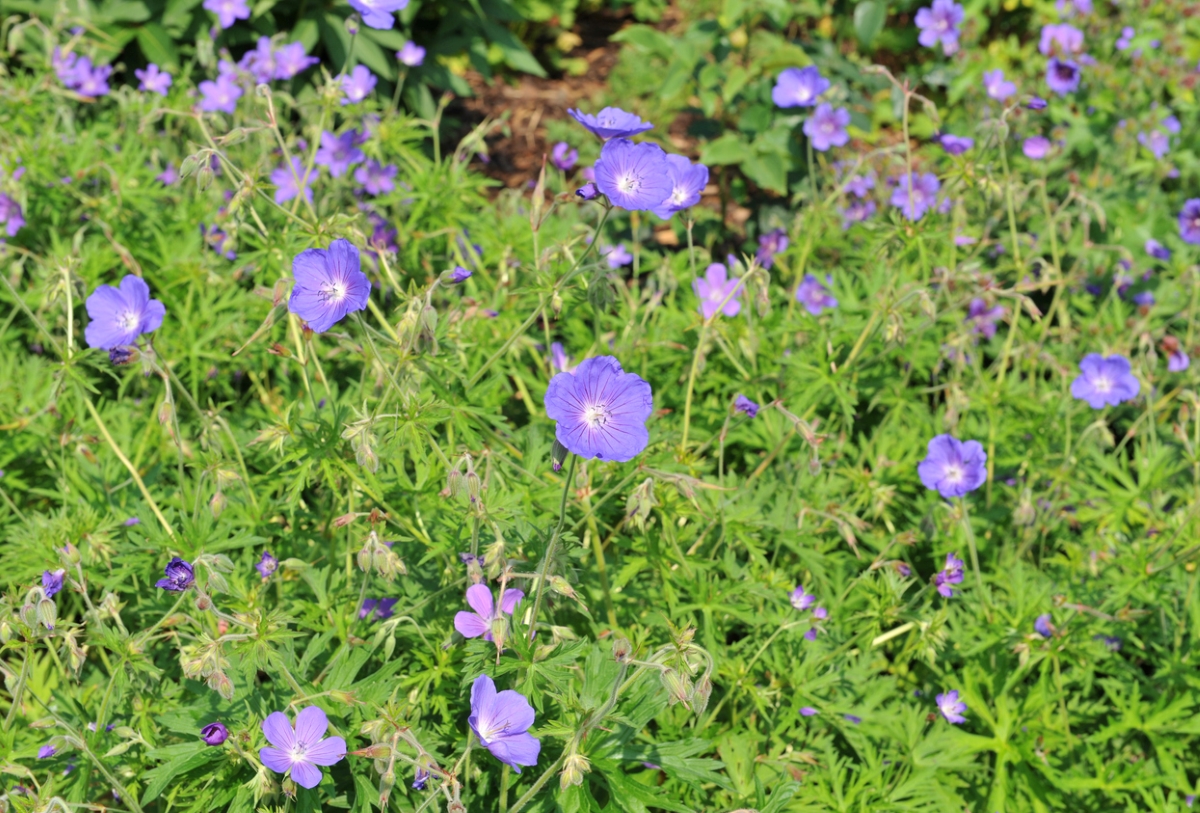
The brookside geranium’s hardy, long-lasting blooms have earned the plant a glowing reputation among long-time gardeners. Enjoy the lovely blue flowers from late spring through summer, and then take in the color-changing leaves during the fall. This perennial will attract butterflies to your garden, and is deer- and rabbit-resistant so you can grow curb appeal, not a salad bar for local wildlife.
USDA hardiness zones: 4 to 8
Mature size: 8 to 24 inches tall; 2 to 3 feet wide
Important to know: Deer and rabbit resistant
24. Ribbon Grass (Phalaris arundinacea)
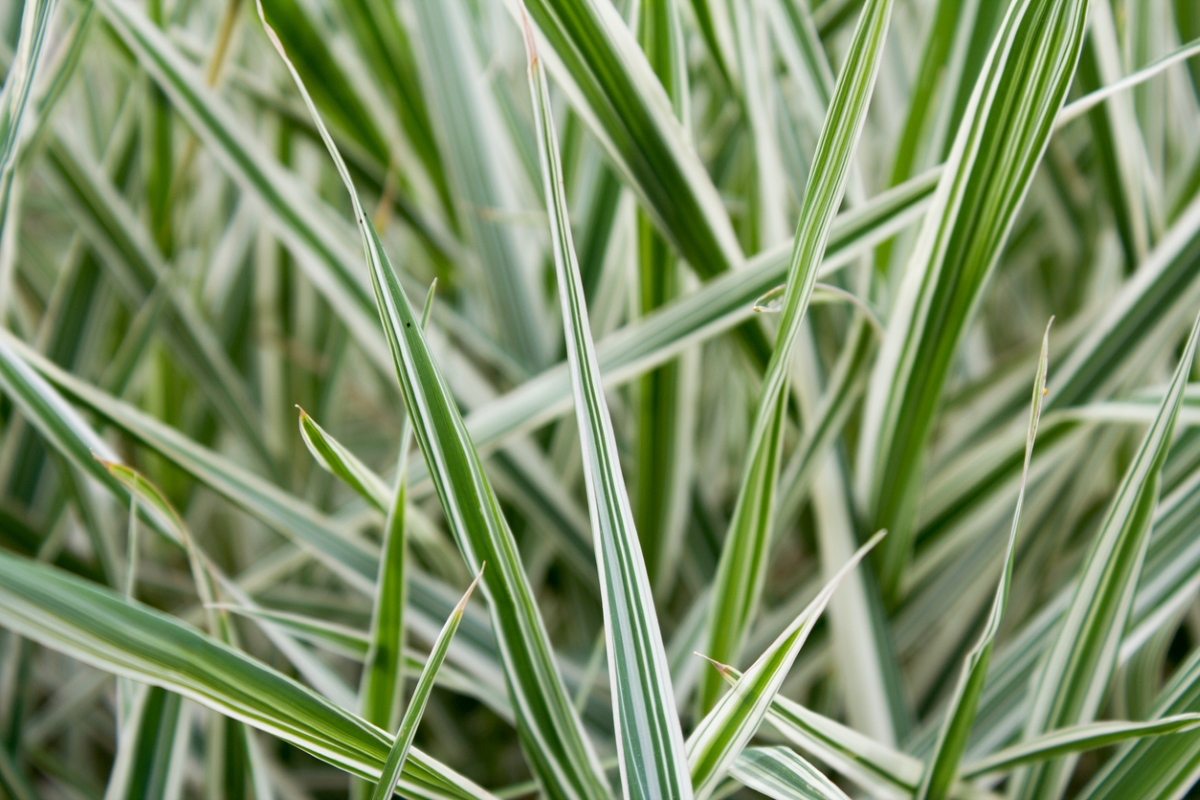
Ribbon grass is an easy boon to a lush garden. As the name suggests, its long, graceful leaves spread to cover swaths of landscaping beds. Ribbon grass does best in moist soil and shade or partial light, and tolerates various climates (zones 4 through 9). The only work required to keep it looking lovely is an inch of water per week and a quick trim each spring to spur fresh growth.
USDA hardiness zones: 3 to 9
Mature size: 2 to 4 feet tall; 2 to 5 feet wide
Important to know: Toxic to pets
25. Coral Bells (Heuchera)
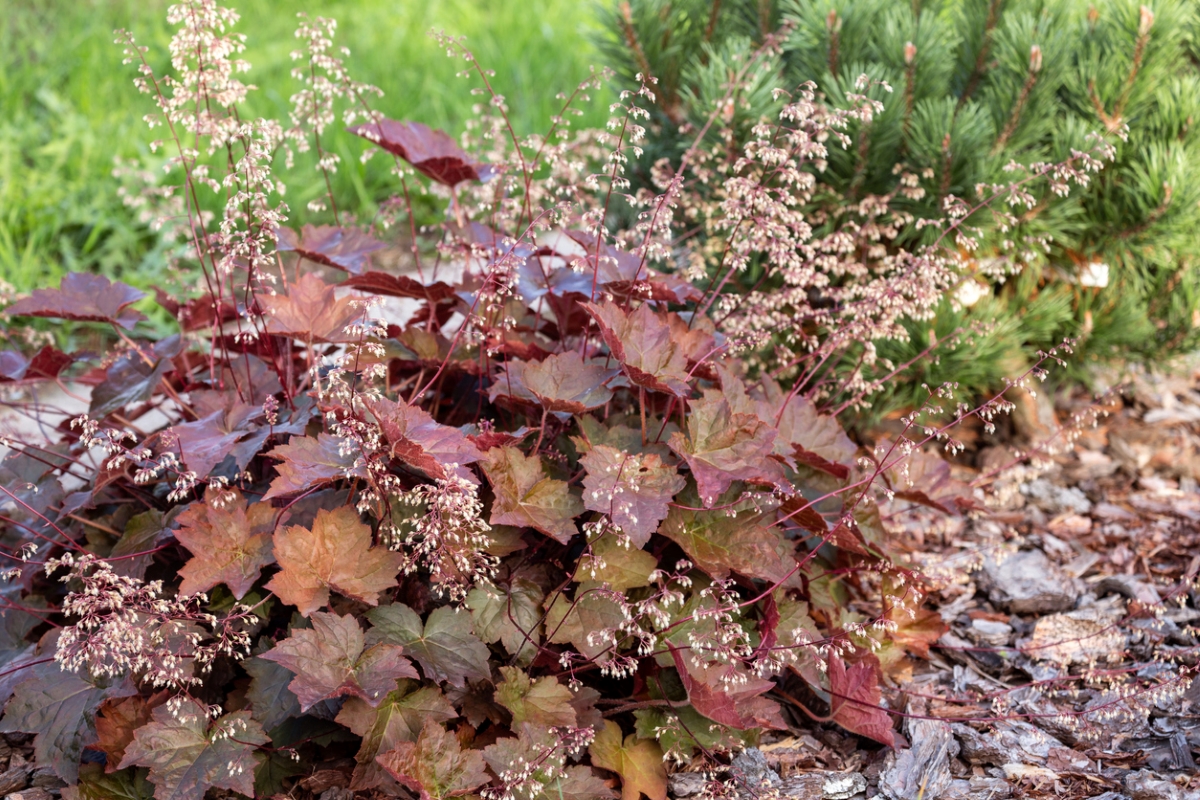
Coral bells is a low-maintenance plant that will add color and texture to your landscape thanks to its flowers and foliage. Its tall, bell-shaped flowers bloom in shades of red, coral, pink, and white during late spring and early summer, but its colorful foliage—greens, golds, and purples—lasts through the first frost. Native to woodland areas, it doesn’t need full sunlight. Little work is required from you once it’s established.
USDA hardiness zones: 3 to 9
Mature size: 8 to 24 inches
Important to know: Deer and rabbit resistant
26. Peonies (Paeonia)
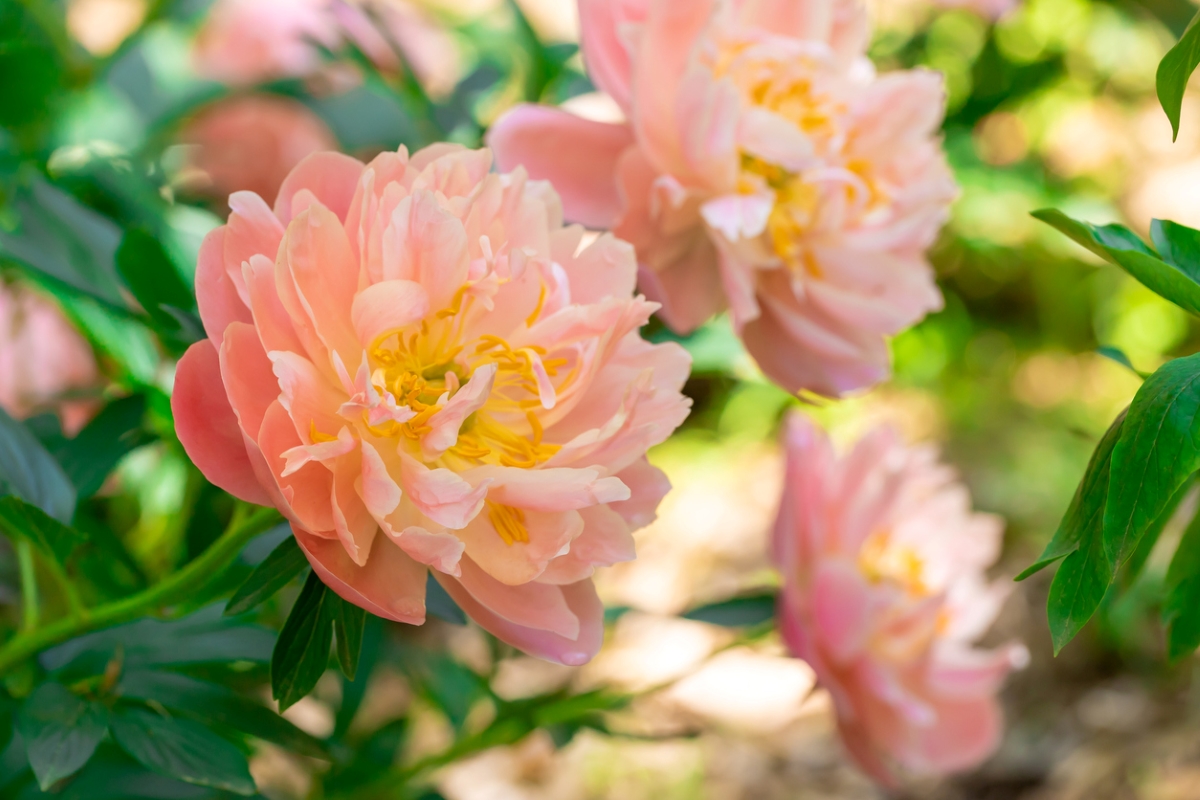
The peony is so many people’s favorite flower for its large, lush petals that delight in varying shades of reds and pinks. But don’t be fooled by this pretty perennial. It’s no delicate flower; it’s actually fairly resilient. The deer- and rabbit-resistant plant prefers full sunlight, well-drained soil, and space to spread out. When a peony blooms, you’ll want to stake it since its flowers will weigh down the branches. While a peony’s blooms only last for a short time (late spring and early summer), the green leaves look good all season long.
USDA hardiness zones: 3 to 8
Mature size: 1 to 3 feet tall and wide
Important to know: Can cause severe gastrointestinal upset to pets if consumed in large quantities.
27. Spotted Laurel (Aucuba japonica)
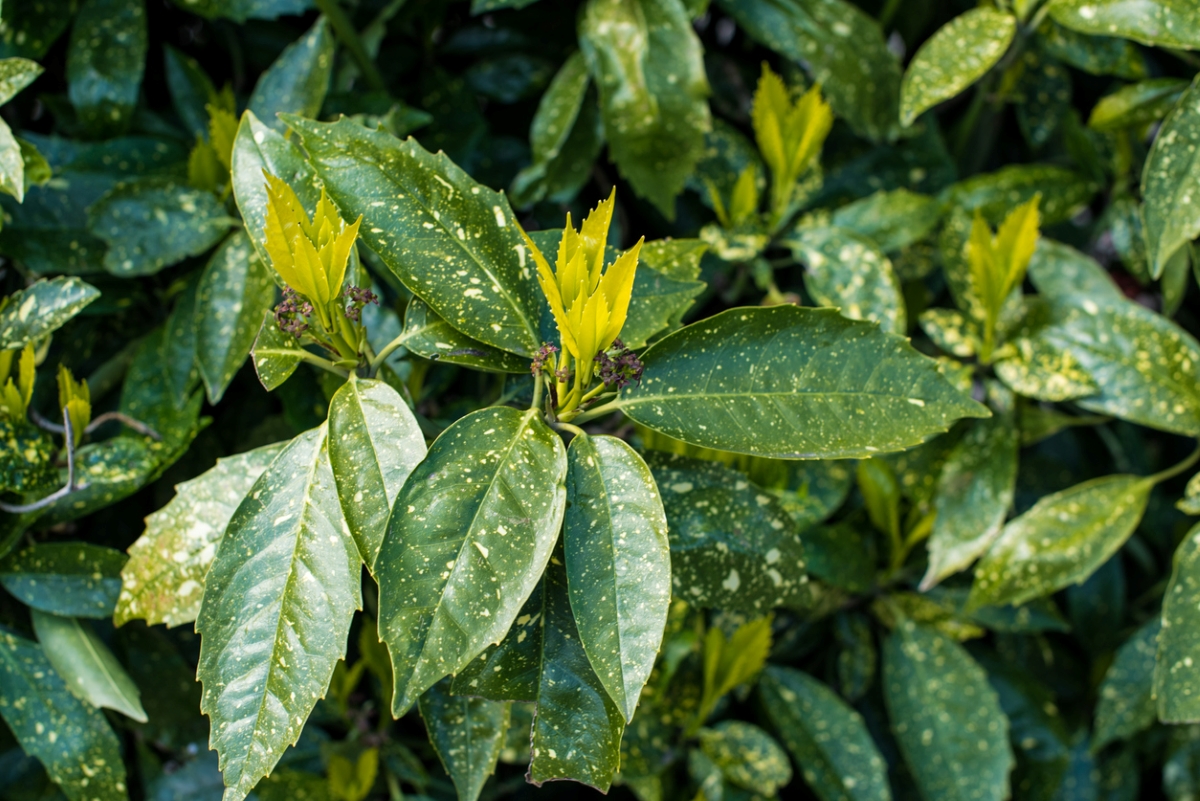
The spotted laurel is an easygoing evergreen that is tolerant of many conditions. With its thick, glossy leaves it’s an excellent choice as a hedge, foundation plant, or container plant. While you might want to keep it trimmed to prevent it from getting too tall or overbearing your path, it grows so slowly you won’t have to do it frequently.
USDA hardiness zones: 7 to 9
Mature size: 4 to 6 feet tall and wide
Important to know: Toxic to pets and people if ingested
28. Marigold (Tagetes)
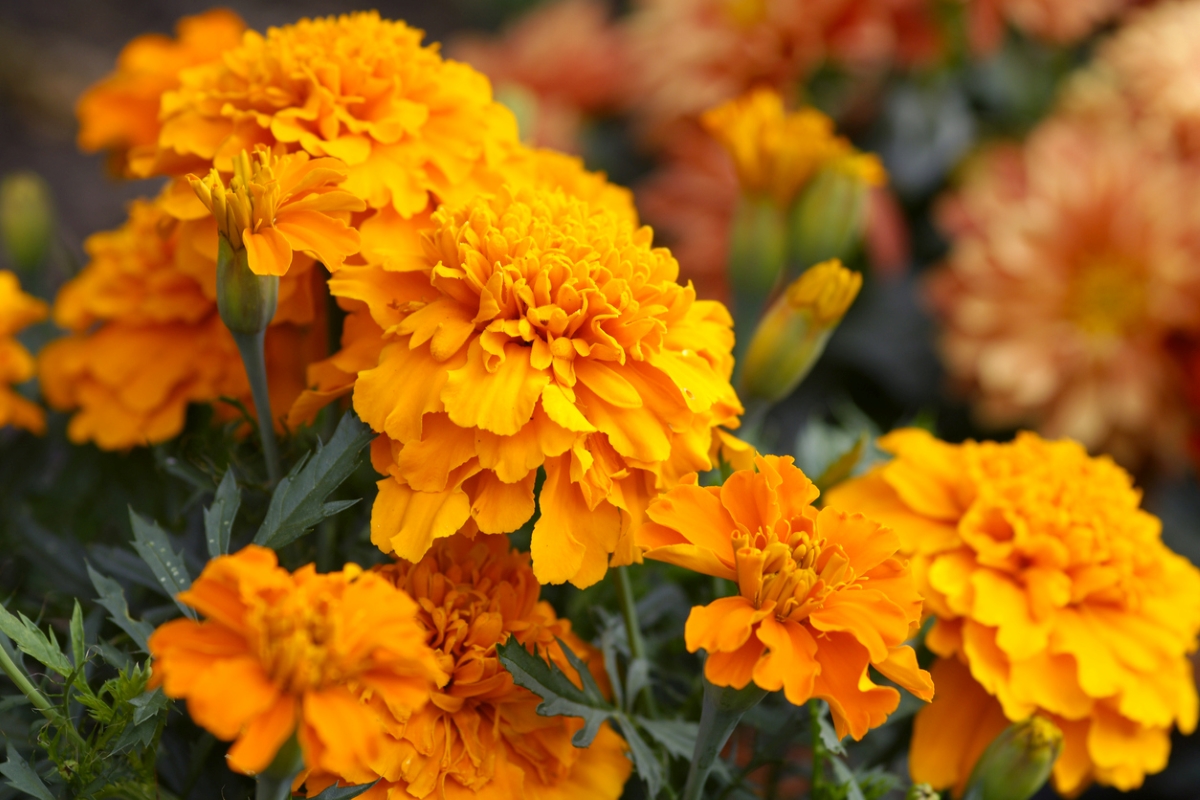
You can trust marigolds to thrive in your yard without having to do much work beyond planting them. Find a spot for them where they can soak up the sun and let nature take over from there. The gold flower isn’t fussy about soil types and won’t wilt from intense heat. Marigolds bloom from spring through fall.
USDA hardiness zones: 2 to 11
Mature size: 6 to 12 inches tall; 6- to 9 inches wide
Important to know: Can cause skin irritation. Can be toxic to pets if eaten in large quantities.
29. Cosmos (Cosmos bipinnatus)
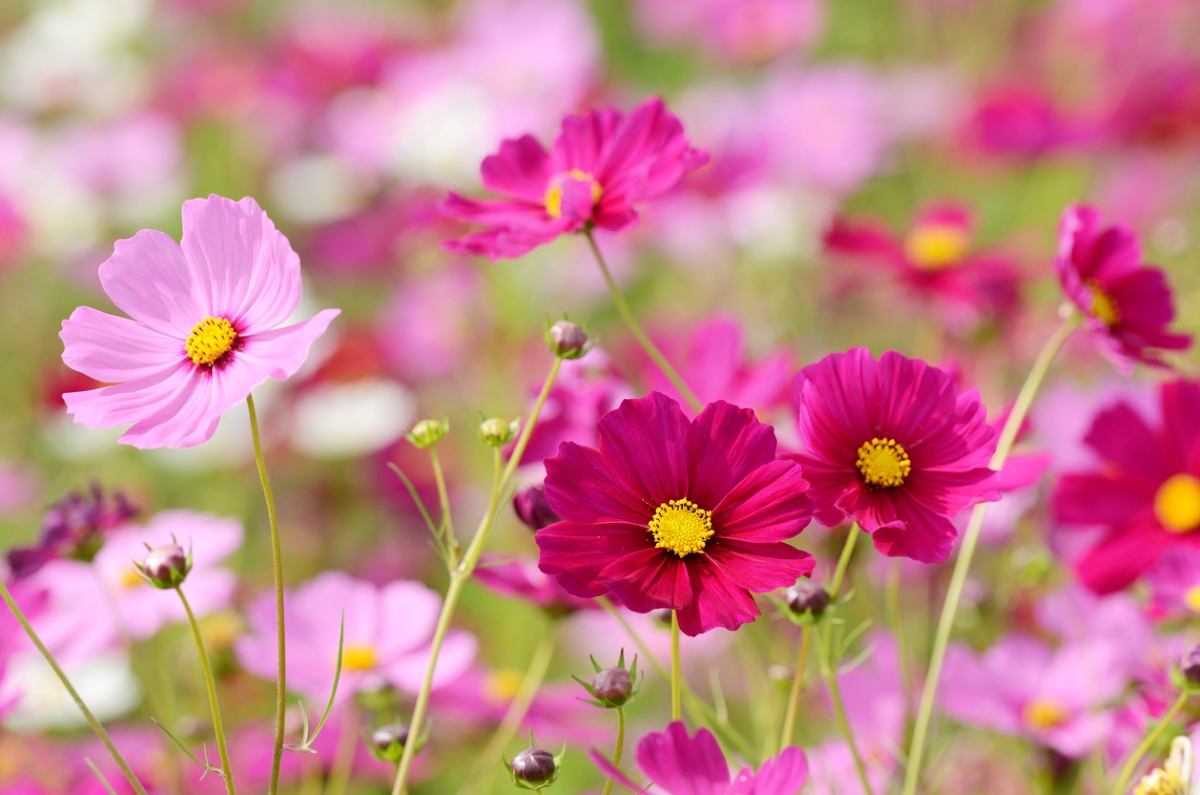
Colorful cosmos is a perfect pick for your summertime garden. The long, delicate flowers are drought and heat tolerant, and will attract birds, bees, and butterflies to your yard. Available in a range of colors, the annuals don’t require special treatment and mix well with other flowers and plants.
USDA hardiness zones: 2 to 11
Mature size: 1 to 6 feet tall; 1 to 3 feet wide
Considerations/important to know: Deer like the flower buds, but otherwise leave this plant alone.
30. Canna Lily (Canna spp.)
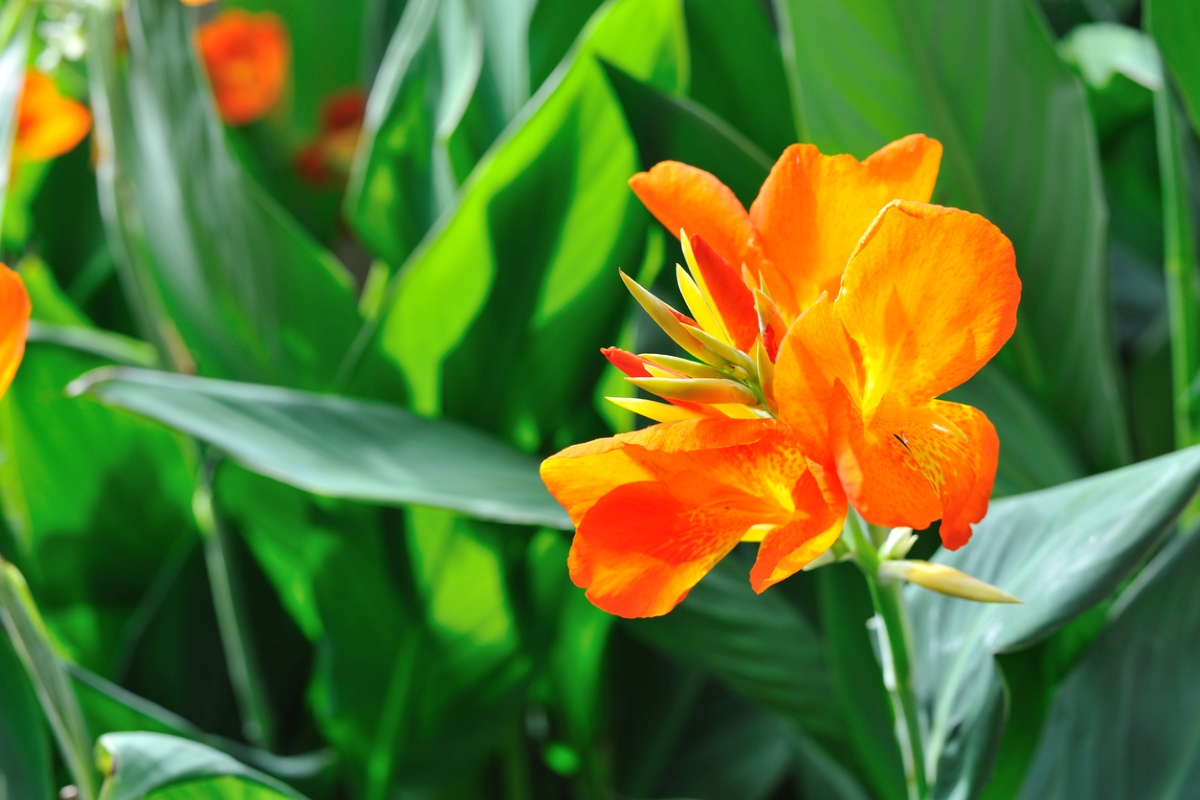
Few plants add so much drama with so little TLC as the canna lily. To grow canna lily, place the bulb in the ground after the threat of frost has passed, then water, cover with mulch, and wait for it to sprout. Once the tropical beauty blooms, you’ll need to keep it moist (but if you forget to water it, the drought-tolerant plant can survive a skipped sprinkler session).
USDA hardiness zones: 6 to 10
Mature size: 1.5 to 8 feet tall; 1.5 to 6 feet tall
Important to know: Attracts hummingbirds
About the Author
A former garden editor for a daily newspaper in Austin, Texas, and an experienced freelance garden writer who’s written for numerous publications, Gretchen Heber loves bringing out the best of her 4 acres of wooded property. She’s never met a succulent she didn’t like, and gets really irritated every 3-4 years when Austin actually has a winter cold enough to kill them. To Gretchen, nothing is more rewarding than a quick dash to the garden to pluck herbs to season the evening meal.

